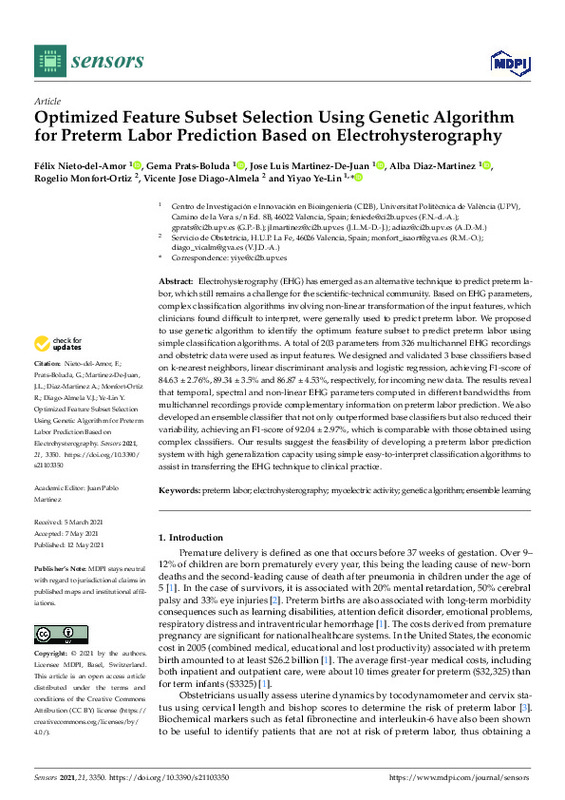JavaScript is disabled for your browser. Some features of this site may not work without it.
Buscar en RiuNet
Listar
Mi cuenta
Estadísticas
Ayuda RiuNet
Admin. UPV
Optimized Feature Subset Selection Using Genetic Algorithm for Preterm Labor Prediction Based on Electrohysterography
Mostrar el registro sencillo del ítem
Ficheros en el ítem
| dc.contributor.author | Nieto-del-Amor, Félix
|
es_ES |
| dc.contributor.author | Prats-Boluda, Gema
|
es_ES |
| dc.contributor.author | Martínez-de-Juan, José L.
|
es_ES |
| dc.contributor.author | Díaz-Martínez, María del Alba
|
es_ES |
| dc.contributor.author | Monfort-Ortiz, Rogelio
|
es_ES |
| dc.contributor.author | Diago-Almela, Vicente Jose
|
es_ES |
| dc.contributor.author | Ye Lin, Yiyao
|
es_ES |
| dc.date.accessioned | 2021-11-05T14:09:41Z | |
| dc.date.available | 2021-11-05T14:09:41Z | |
| dc.date.issued | 2021-05 | es_ES |
| dc.identifier.uri | http://hdl.handle.net/10251/176381 | |
| dc.description.abstract | [EN] Electrohysterography (EHG) has emerged as an alternative technique to predict preterm labor, which still remains a challenge for the scientific-technical community. Based on EHG parameters, complex classification algorithms involving non-linear transformation of the input features, which clinicians found difficult to interpret, were generally used to predict preterm labor. We proposed to use genetic algorithm to identify the optimum feature subset to predict preterm labor using simple classification algorithms. A total of 203 parameters from 326 multichannel EHG recordings and obstetric data were used as input features. We designed and validated 3 base classifiers based on k-nearest neighbors, linear discriminant analysis and logistic regression, achieving F1-score of 84.63 ± 2.76%, 89.34 ± 3.5% and 86.87 ± 4.53%, respectively, for incoming new data. The results reveal that temporal, spectral and non-linear EHG parameters computed in different bandwidths from multichannel recordings provide complementary information on preterm labor prediction. We also developed an ensemble classifier that not only outperformed base classifiers but also reduced their variability, achieving an F1-score of 92.04 ± 2.97%, which is comparable with those obtained using complex classifiers. Our results suggest the feasibility of developing a preterm labor prediction system with high generalization capacity using simple easy-to-interpret classification algorithms to assist in transferring the EHG technique to clinical practice. | es_ES |
| dc.description.sponsorship | This work was supported by the Spanish Ministry of Economy and Competitiveness, the European Regional Development Fund (MCIU/AEI/FEDER, UE RTI2018-094449-A-I00-AR) and by the Generalitat Valenciana (AICO/2019/220). | es_ES |
| dc.language | Inglés | es_ES |
| dc.publisher | MDPI AG | es_ES |
| dc.relation.ispartof | Sensors | es_ES |
| dc.rights | Reconocimiento (by) | es_ES |
| dc.subject | Preterm labor | es_ES |
| dc.subject | Electrohysterography | es_ES |
| dc.subject | Myoelectric activity | es_ES |
| dc.subject | Genetic algorithm | es_ES |
| dc.subject | Ensemble learning | es_ES |
| dc.subject.classification | TECNOLOGIA ELECTRONICA | es_ES |
| dc.title | Optimized Feature Subset Selection Using Genetic Algorithm for Preterm Labor Prediction Based on Electrohysterography | es_ES |
| dc.type | Artículo | es_ES |
| dc.identifier.doi | 10.3390/s21103350 | es_ES |
| dc.relation.projectID | info:eu-repo/grantAgreement/AEI/Plan Estatal de Investigación Científica y Técnica y de Innovación 2017-2020/RTI2018-094449-A-I00/ES/ELECTROHISTEROGRAFIA PARA LA MEJORA EN LA TOMA DE DECISIONES EN SITUACIONES DE RIESGO EN OBSTETRICIA: PARTO PREMATURO E INDUCCION DEL PARTO/ | es_ES |
| dc.relation.projectID | info:eu-repo/grantAgreement/GENERALITAT VALENCIANA//AICO%2F2019%2F220//DESARROLLO DE HERRAMIENTAS DE USO CLINICO PARA LA PREDICCION DEL PARTO PREMATURO EN BASE A LA ELECTROHISTEROGRAFIA/ | es_ES |
| dc.rights.accessRights | Abierto | es_ES |
| dc.contributor.affiliation | Universitat Politècnica de València. Departamento de Ingeniería Electrónica - Departament d'Enginyeria Electrònica | es_ES |
| dc.description.bibliographicCitation | Nieto-Del-Amor, F.; Prats-Boluda, G.; Martínez-De-Juan, JL.; Díaz-Martínez, MDA.; Monfort-Ortiz, R.; Diago-Almela, VJ.; Ye Lin, Y. (2021). Optimized Feature Subset Selection Using Genetic Algorithm for Preterm Labor Prediction Based on Electrohysterography. Sensors. 21(10):1-15. https://doi.org/10.3390/s21103350 | es_ES |
| dc.description.accrualMethod | S | es_ES |
| dc.relation.publisherversion | https://doi.org/10.3390/s21103350 | es_ES |
| dc.description.upvformatpinicio | 1 | es_ES |
| dc.description.upvformatpfin | 15 | es_ES |
| dc.type.version | info:eu-repo/semantics/publishedVersion | es_ES |
| dc.description.volume | 21 | es_ES |
| dc.description.issue | 10 | es_ES |
| dc.identifier.eissn | 1424-8220 | es_ES |
| dc.identifier.pmid | 34065847 | es_ES |
| dc.identifier.pmcid | PMC8151582 | es_ES |
| dc.relation.pasarela | S\437671 | es_ES |
| dc.contributor.funder | GENERALITAT VALENCIANA | es_ES |
| dc.contributor.funder | AGENCIA ESTATAL DE INVESTIGACION | es_ES |
| dc.contributor.funder | European Regional Development Fund | es_ES |
| dc.subject.ods | 03.- Garantizar una vida saludable y promover el bienestar para todos y todas en todas las edades | es_ES |
| upv.costeAPC | 1173 | es_ES |








